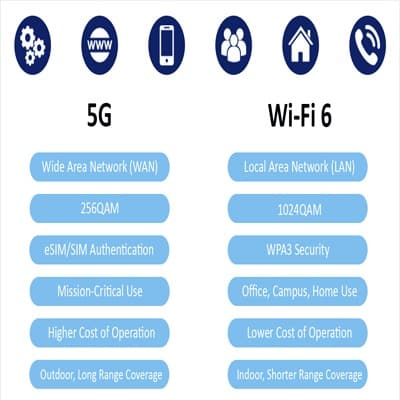
What is the distinction between 5G and Wi-Fi 6? Compare and contrast these two remarkable—and very different—technologies, and discover how they will collaborate to create new linked experiences.
The Distinction Between 5G and Wi-Fi 6
For many years, two forms of wireless technology coexisted. Wi-Fi is a sort of local area network (LAN) that is mostly utilized inside, such as in a house or office. Cellular networks, such as the 4G LTE networks used by major operators, are a sort of wide-area network (WAN) that is utilized both indoors and outside across great distances.
Both 5G and Wi-Fi 6 are complementary technologies that outperform their predecessors in terms of speed, latency, and capacity. But what is each technology best for?
What Is 5G?
5G networks will be 50 times faster, 10 times less latency, and 1,000 times larger than 4G/LTE networks.
As a result, 5G will be able to connect more devices and send more data than ever before, resulting in faster connection and vastly improved user experiences. As with LTE, mobile carriers will provide 5G network subscriptions, which will need the use of 5G-capable devices.
What Is Wi-Fi 6?
Wi-Fi 6, which is based on the IEEE 802.11ax standard, will have four times the capacity and seven times the latency of its predecessor. Wi-Fi 5.2, and will be roughly three times faster. A Wi-Fi network may be operated by anybody. Many of us have one of these in our homes or businesses that is connected to internet service. Wi-Fi 6 devices must be connected to a Wi-Fi 6 compatible access point to benefit from the full speed, reliability, and capacity increases.
How Do 5G and Wi-Fi Interact?
The functionalities of Wi-Fi and 5G are complementary. In terms of user experience, both 5G and Wi-Fi 6 can deliver gigabit speeds with low latency.
Wi-Fi will continue to be the dominant technology in household and corporate settings. It is less expensive to adopt, run, and scale. Especially when access points must serve more users. This provides outstanding support for hundreds of data-hungry devices that must connect to the network. Such as PCs, tablets, smartphones, streaming devices, television sets, and printers. It will be used for mobile communication, such as smartphones, because of their longer range. It will also be used in connected cars, smart cities, and large-scale manufacturing.
Network management is handled differently in the two technologies. Because Wi-Fi operates on an unlicensed spectrum, you and your neighbors may each establish their Wi-Fi network without having to obtain a license. However, how many neighbors are using their network at the same time and on the same channel as you might influence your Wi-Fi performance. Wi-Fi is typically intensively controlled in offices and other corporate contexts to reach the desired performance target.
Operators often administer 5G and LTE networks, which employ a specific, licensed spectrum that needs subscription fees to use. The amount of “bars” you have—that is, how close you are to a base station—, as well as the number of people using the network, will affect 5G speed, just like it did with LTE.
Of course, there are exceptions to these broad generalizations. Finally, whether to use 5G or Wi-Fi 6 is determined by the specific use case.
Core networks, which serve as the backbone for all Internet access, are evolving alongside Wi-Fi and cellular wireless technologies. This practice is known as Cloudification. It extends the use of data center technologies from the cloud into the network. Cloudification lays the framework for carriers to handle increased data volumes. Billions of connected nodes, allowing for new use cases.
Intel applies its cloud computing expertise to the networks that power 5G and Wi-Fi, becoming a part of the network fabric in the same way that our technologies serve as the backbone of data centers.
Is the combination of these network technologies important to the development of 5G? Yes, Wi-Fi 6 and 5G provide next-generation, seamless wireless capabilities.”
Wi-Fi 6 and 5G home networking
Because 5G provides such a significant performance gain, service providers may give consumers another option for delivering internet access to the home: wireless broadband through 5G. It may compete with cable or fiber options in this area.
Wi-Fi, on the other hand, will continue to be the most efficient way to link the expanding number of devices in the house. They include PCs, tablets, smartphones, smart speakers, home security cameras, thermostats, and appliances.
Powering the IoT and Edge Devices of the Future
Some of the most fascinating 5G and Wi-Fi 6 applications will include the Internet of Things (IoT). Businesses can choose the wireless technology that best meets their needs. While still ensuring that devices can transfer data quickly and reliably.
Manufacturing automation, for example, relies heavily on machine-to-machine communication. While Wi-Fi 6 may be sufficient for a regulated industrial environment, 5G may be required to augment a large, campus-wide manufacturing environment.
In some cases, Wi-Fi and 5G can be used together. A connected car, for example, might connect to a cellular network while also providing in-vehicle Wi-Fi for consumers’ devices.
Wi-Fi 6 and Intel® 5G technologies
Intel is at the forefront of 5G and Wi-Fi 6 advances, from standardization to supplying core computational resources for a variety of devices. Intel® Wi-Fi 6 (Gig +) enables Wi-Fi 6 performance in routers and access points, as well as PCs and other client devices. On the cellular front, Intel® 5G technologies provide network operators throughout the world with unprecedented possibilities for network transformation and optimization.
Wi-Fi 6 and 5G are not rivals in a zero-sum game; rather, they will collaborate to provide next-generation experiences. Today’s agile networks are developing to optimize traffic for seamless experiences across all network types, thanks to Intel technology.
